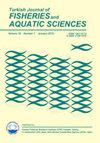工程氧化铜纳米颗粒对淡水鱼的毒性评价
IF 1.7
4区 农林科学
Q3 FISHERIES
引用次数: 3
摘要
随着纳米技术相关产业的快速发展,纳米产品的不当处理可能会在水生生态系统中引发新的污染源,从而可能对水生生物造成危害。本研究评估了32.84nm大小和棒状的水性氧化铜纳米颗粒(CuO-NPs)对淡水鱼Labeo rohita的生态毒理学效应。CuO-NPs 96 h LC50为353.98mg/L。选择相当于1/3和1/5 LC50/96h(70.79和117.99 mg/L)的CuO-NPs两个亚致死浓度进行15、30和45天的暴露试验。CuO-NPs在96h LC50的1/3积累量显著高于96h LC50的1/5。CAT活性急剧下降,最终导致TBARS含量增加。在最高浓度和处理45 d后,鱼红细胞的细胞核损伤率和遗传损伤指数最高。在所有研究时间间隔内,CuO-NPs的不良反应均呈剂量和持续时间依赖性,且程度增加。综上所述,暴露于亚致死浓度的CuO-NPs足以引起生态毒理学终点的改变,如慢性暴露后的金属过载、氧化应激和遗传毒性。本文章由计算机程序翻译,如有差异,请以英文原文为准。
Evaluation of Toxicity Induced by Engineered CuO Nanoparticles in Freshwater Fish, Labeo rohita
With the fast development of industries relevant to nanotechnology, the inappropriate disposal of nanoproducts may initiate a new source of pollution in aquatic ecosystems, thus posing a possible danger to aquatic life. This study evaluated the eco-toxicological effects of waterborne copper oxide nanoparticles (CuO-NPs) having a 32.84nm size and rod shape on a freshwater fish, Labeo rohita. 96-h LC50 of CuO-NPs was 353.98mg/L. Two sub-lethal concentrations equivalent to 1/3rd and 1/5th LC50/96h (70.79 and 117.99 mg/L) of CuO-NPs were selected for 15, 30, and 45-day exposure tests. Bioaccumulation for the 1/3rd 96h LC50 was significantly higher compared to 1/5th of 96-h LC50 of CuO-NPs. There was a sharp decrease in the CAT activity and this decline ultimately increased the TBARS contents. The highest percentage of damaged nuclei and genetic damage index in fish erythrocytes was recorded at the highest concentration and after 45 days of treatment. The adverse effects of CuO-NPs were examined to be dose and duration dependent with increasing extent during all studied time intervals. Summarizing, exposure to sublethal concentrations of CuO-NPs is sufficient to cause alterations in ecotoxicological endpoints such as metal overload, oxidative stress and genotoxicity after chronic exposure.
求助全文
通过发布文献求助,成功后即可免费获取论文全文。
去求助
来源期刊

Turkish Journal of Fisheries and Aquatic Sciences
FISHERIES-MARINE & FRESHWATER BIOLOGY
CiteScore
3.10
自引率
0.00%
发文量
43
审稿时长
3 months
期刊介绍:
Turkish Journal of Fisheries and Aquatic Sciences" (TrJFAS) is a refereed academic journal has been published by Central Fisheries Research Institute of Turkey and Japan International Cooperation Agency (JICA), and published in English.
It aims to address research and needs of all working and studying within the many varied areas of fisheries and aquatic sciences.
The Journal publishes English language original research papers, critical review articles, short communications and technical notes on applied or scientific research relevant to freshwater, brackish and marine environments.
TrJFAS was published biannually (April & November) between 2001 and 2009. A great number of manuscripts have been submitted to the journal for review from acceptance of the SCI index. Thereby, the journal has been published quarterly (March, June, September and December) from 2010 to 2017. The journal will be published monthly in 2018.
 求助内容:
求助内容: 应助结果提醒方式:
应助结果提醒方式:


